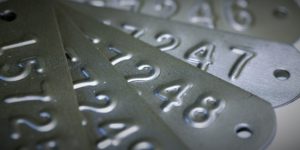Not only are vineyards businesses, but also a popular place to visit. Providing easily accessible information to both workers as well as guests is crucial to success.
Proper labeling, marking, and identifying using vineyard tags ensures a smooth and successful operation.
Applications
Labeling
When farming and harvesting crops, organization is crucial. Vineyards rely on accurate labels for identifying their assets.
One of the most common types of labeling you’ll find at a vineyard is row and block marking. Rows in a large scale vineyard operation can be easy to get mixed up. Fence posts with numbers help provide clarity as to exactly which row number is which.
This eliminates any guesswork and saves time hunting down the right block or row. This is important when managing or documenting the harvest and its growth.
Other items commonly labelled include wine barrels and harvest bins. There is never an end to the number of assets needing marked or identified at a vineyard.
Tours
Vineyards which generate additional revenue from tours and tastings can use tags to accurately mark information for guests to read.
Information can include everything from the species of plant, the year it was planted, flavor it produces, etc.
Serialized Embossed Tags
Sometimes keeping things simple is the best policy. Serialized embossed tags feature consecutive numbering for marking assets, inventory, and more.

These durable tags are often used for marking barrels as well as fence posts. By providing a basic numbering system, inventory can be monitored, and locating specific rows in the vineyard becomes much easier.
MetalPhoto Nameplates
This type of nameplate is perfect for tour plaques offering details on a specific year, type of plant, etc.
QR Codes can be included for visitors to scan. This could link them to more info, or send them to a website ordering page to purchase what they are sampling.

Barcode tags can also be used by workers to feed data into an asset management system. This can be used to track processes from start to finish. From planting and harvest to sale of finished bottles.
Tracking information can be very important the final products will be locally shipped or distributed to nearby bars, restaurants, or beverage retailers.
Durability
As with many applications, durability is a major factor. Vineyard post tags need to be highly resilient as they are exposed to weather, water, and other conditions on a continuous basis.
While plastic or paper marking will fade and wear, metal substrates provide a more permanent marking solution.
Metal post tags offer immense durability, while providing information that is clear and easy to read.
Materials
Anodized Aluminum
Anodized aluminum is a popular material due to its lightweight but resilient nature.
In addition, the material can be adorned with a solid color. This provides the ability to sort via color coding. Color coding works great for quickly identifying various barrels, or marking different rows.
Stainless Steel
Another commonly used material relied upon for marking purposes is stainless steel. This substrate provides the highest level of durability in a metal identification nameplate.
Similarly to anodized aluminum, stainless will also not corrode when exposed to harsh conditions.
Marking Processes
Embossing/Stamping
When you need your information marked permanently, embossing and stamping are two of the most durable options.
This process uses a stamp or embossing die set to embed a custom design into a blank metal substrate.

Embossing creates a raised design, while stamping indents the information into the tag.
While the marking is durable, the die process is limited in terms of customization. Each new design requires a custom stamp to be produced. This is not cost effective if the stamp will only be used a handful of times.
Specialized numbering heads allow for tags to be marked with consecutive numbers. Serialized embossed tags are an excellent way to manage and track assets and inventory. They are perfect for vineyard row posts or barrels
Photo Anodization
Photo anodization uses a special process to embed information beneath an anodic layer for high levels of scratch resistance and overall durability.
While its signature black on aluminum look stands out, a solid background color can be added for even more pop.

This process is rated for 20+ years outdoors, making this a viable option in vineyards and wineries.
Unlike stamping or embossing, this process doesn’t require the production of a new stamp or die set for every new design. Every single plate or placard can include unique information or imaging.
Wrap-Up
From marking barrels to labeling rows and providing more info to guests, identification nameplates are a fundamental element of modern vineyards.
With the added ability to track inventory and other assets, the potential uses are endless.